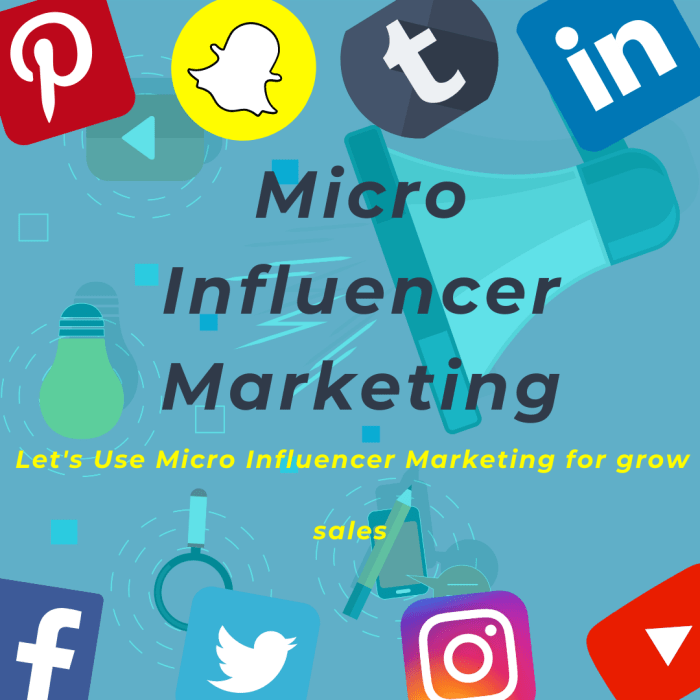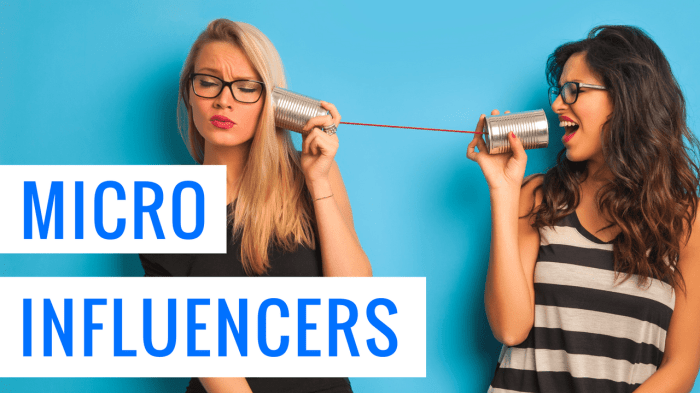Using Micro-Influencers in Marketing kicks off a game-changing strategy for brands looking to connect with their audience on a more personal level. Get ready to dive into the world of influencer marketing where authenticity is key.
From identifying the right influencers to measuring campaign impact, this guide will take you through the ins and outs of leveraging micro-influencers for your brand.
Overview of Using Micro-Influencers in Marketing

Micro-influencers are individuals who have a smaller but highly engaged following on social media platforms. They are considered experts in their niche and have the ability to influence their audience’s purchasing decisions. In marketing, micro-influencers play a crucial role in spreading brand awareness, increasing engagement, and driving conversions.
Examples of Successful Marketing Campaigns with Micro-Influencers, Using Micro-Influencers in Marketing
- One successful marketing campaign that utilized micro-influencers was the collaboration between Daniel Wellington, a watch brand, and various fashion bloggers on Instagram. These micro-influencers posted stylish images wearing the brand’s watches, which led to a significant increase in brand visibility and sales.
- In another example, the skincare brand Glossier partnered with micro-influencers to create authentic and relatable content about their products. This strategy helped Glossier reach a wider audience and build trust among consumers.
Benefits of Using Micro-Influencers over Macro-Influencers
- Micro-influencers often have a more engaged and loyal following compared to macro-influencers, resulting in higher conversion rates for brands.
- Collaborating with micro-influencers is more cost-effective for brands, as they typically charge lower rates for sponsored posts than macro-influencers or celebrities.
- Micro-influencers are perceived as more authentic and trustworthy by their followers, leading to a higher level of credibility for brands that partner with them.
Finding the Right Micro-Influencers

When it comes to finding the perfect micro-influencers for your brand, it’s essential to have a strategic approach. You want to ensure that the influencers you choose align with your brand’s values and can authentically engage with your target audience. Let’s dive into some strategies and tips for identifying the right micro-influencers.
Identifying Suitable Micro-Influencers
- Utilize social media listening tools to identify influencers who are already talking about topics related to your brand.
- Look for influencers who have a genuine passion for your industry or niche, rather than just chasing followers.
- Consider influencers who have a strong engagement rate with their audience, as this indicates authenticity and influence.
Aligning Influencer Values with Brand Values
- Ensure that the influencer’s personal values and content align with your brand’s mission and values.
- Check past content to see if the influencer has promoted conflicting brands or messages that could harm your brand reputation.
- Collaborate with influencers who genuinely believe in your product or service to maintain authenticity in their endorsements.
Evaluating Influencer’s Engagement and Authenticity
- Look at the influencer’s engagement metrics, such as likes, comments, and shares, to gauge their level of influence.
- Check for signs of fake followers or engagement, such as a high number of likes but low comments or lack of genuine interaction.
- Review the influencer’s content to see if it feels authentic and resonates with their audience, rather than being overly promotional.
Collaborating with Micro-Influencers
To establish successful partnerships with micro-influencers, it’s important to approach them professionally and with a clear plan in mind. Building a positive relationship with micro-influencers can lead to fruitful collaborations that benefit both parties involved.
Reaching Out and Establishing Partnerships
When reaching out to micro-influencers, personalize your messages to show that you have done your research and are genuinely interested in working with them. Clearly Artikel your campaign goals, target audience, and the benefits of collaborating with you. Be transparent about what you expect from them and what they can expect from you in return.
- Research potential micro-influencers that align with your brand values and target audience.
- Engage with their content before reaching out to establish a connection.
- Provide a clear and concise proposal outlining the partnership details.
Negotiating Terms, Contracts, and Compensation
When negotiating terms, contracts, and compensation with micro-influencers, it’s essential to be fair and transparent. Clearly Artikel deliverables, timelines, usage rights, and payment terms to avoid any misunderstandings down the line. Establish a mutually beneficial agreement that values the work of the micro-influencer.
- Discuss the scope of work and expected deliverables in detail.
- Negotiate compensation based on the influencer’s reach, engagement rates, and expertise.
- Ensure both parties agree on usage rights and exclusivity clauses.
Maintaining a Positive Relationship
To maintain a positive relationship with micro-influencers, communication is key. Keep them informed about campaign progress, provide feedback on their content, and show appreciation for their work. Building a strong and trusting relationship can lead to long-term collaborations and mutual success.
- Regularly check in with the influencer to provide updates and feedback.
- Show appreciation for their content and the impact it has on your campaign.
- Offer opportunities for collaboration beyond a single campaign to foster a lasting partnership.
Measuring the Impact of Micro-Influencer Campaigns: Using Micro-Influencers In Marketing
When it comes to measuring the impact of micro-influencer campaigns, it’s essential to track key performance indicators (KPIs) that can help determine the success of your efforts. By analyzing the effectiveness of your campaigns, you can make informed decisions on how to optimize future collaborations and maximize your ROI.
Key Performance Indicators (KPIs)
- Engagement Rate: Measure the level of interaction and involvement from the audience with the content created by micro-influencers. This includes likes, comments, shares, and overall engagement on social media platforms.
- Reach and Impressions: Evaluate the number of people who have seen the content shared by micro-influencers. This metric helps in understanding the overall visibility and exposure of the campaign.
- Conversion Rate: Track the number of conversions or actions taken by the audience as a result of the micro-influencer campaign. This could include website visits, sign-ups, purchases, or other desired outcomes.
Tools and Methods for Tracking and Analyzing Campaigns
- Social Media Analytics: Utilize built-in analytics tools on platforms like Instagram, Facebook, and Twitter to monitor the performance of posts shared by micro-influencers.
- URL Tracking: Implement unique tracking links or UTM parameters to measure the traffic and conversions generated through specific influencer collaborations.
- Influencer Marketing Platforms: Leverage specialized platforms that offer detailed insights and analytics on the impact of micro-influencer campaigns, helping you track ROI effectively.
Interpreting Data for Optimization
- Identify High-Performing Content: Analyze the data to identify which type of content or messaging resonates best with the audience, and replicate successful strategies in future campaigns.
- Adjust Collaboration Strategies: Use insights from the data to refine your approach when collaborating with micro-influencers, focusing on partnerships that drive the most significant results.
- A/B Testing: Experiment with different variables within your campaigns to determine what drives the most engagement and conversions, allowing you to optimize future collaborations based on data-driven decisions.